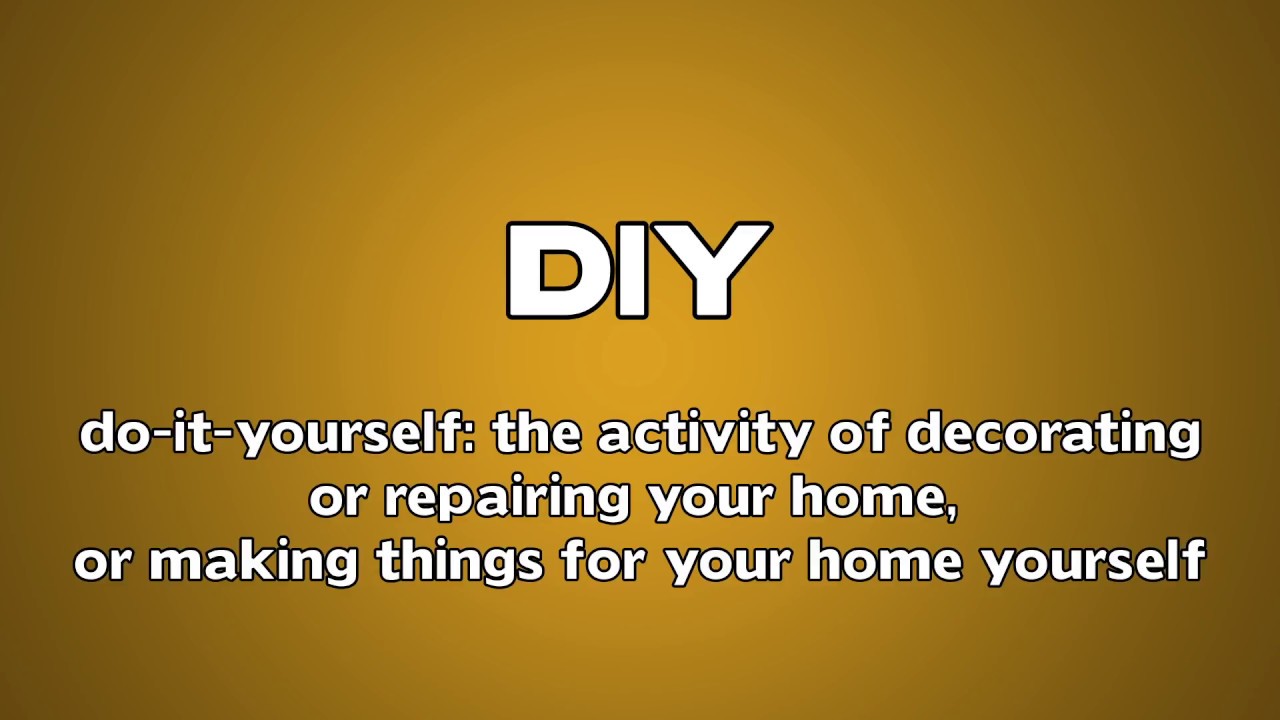DIY Meaning: Exploring the Power of Doing It Yourself, delves into the essence of this popular movement, its historical roots, and its impact on various aspects of our lives. From crafting furniture to building communities, DIY embodies a spirit of self-reliance, creativity, and resourcefulness that has resonated throughout history.
The DIY ethos encourages individuals to take control of their environment, embrace challenges, and learn new skills. It fosters a sense of accomplishment and empowers people to create, innovate, and make a positive impact on their surroundings. Whether it’s fixing a leaky faucet, building a birdhouse, or designing a website, DIY projects offer a rewarding experience that goes beyond simply completing a task.
The Essence of DIY

DIY, or “Do It Yourself,” embodies a spirit of self-reliance, creativity, and resourcefulness. It encourages individuals to take ownership of projects and tasks, fostering a sense of accomplishment and empowerment. The core values of DIY are rooted in independence, resourcefulness, and the pursuit of personal fulfillment through hands-on creation.
Historical Origins and Evolution of DIY
The DIY movement has deep historical roots, tracing back to the early days of human civilization. Throughout history, individuals have relied on their own ingenuity and skills to create and repair items, from basic tools to intricate structures. The industrial revolution, with its mass production of standardized goods, initially seemed to diminish the need for DIY skills. However, the rise of consumerism and the desire for personalized solutions led to a resurgence of DIY in the mid-20th century.
The invention of the personal computer in the 1970s and the subsequent development of the internet in the 1990s played a pivotal role in expanding the reach and influence of DIY. Online communities and forums became hubs for sharing knowledge, techniques, and inspiration. DIY enthusiasts could now access a vast array of information and connect with others who shared their passion for self-sufficiency.
Impact of DIY on Society
DIY has had a profound impact on various aspects of society, from the economy to culture and personal well-being.
- Economic Impact: DIY projects can help individuals save money by avoiding the cost of hiring professionals. The rise of DIY has also led to the creation of new industries, such as home improvement stores and online marketplaces dedicated to DIY supplies.
- Cultural Impact: DIY has become a significant cultural force, influencing fashion, music, art, and design. The maker movement, which emphasizes hands-on creation and innovation, is a direct outgrowth of the DIY spirit. DIY projects have also become a popular form of entertainment and recreation, providing individuals with a creative outlet and a sense of accomplishment.
- Personal Well-being: Engaging in DIY projects can have positive effects on mental and physical well-being. The process of creating something from scratch can be therapeutic and stress-relieving. It can also foster a sense of purpose and satisfaction, promoting feelings of self-efficacy and control.
DIY and Personal Growth
The act of creating something with your own hands, whether it’s a simple project or a complex undertaking, can be a profoundly enriching experience. DIY projects go beyond simply building something; they offer a unique avenue for personal growth and development, nurturing skills, boosting confidence, and fostering a sense of accomplishment.
Psychological Benefits of DIY
Engaging in DIY activities provides numerous psychological benefits that contribute to overall well-being. These activities offer a sense of control and mastery over one’s environment, leading to increased self-efficacy and a sense of accomplishment.
- Stress Reduction: DIY projects can be a form of mindfulness, allowing individuals to focus on the present moment and channel their energy into a creative outlet. The act of working with your hands and completing a task can be a meditative experience, reducing stress and anxiety.
- Boost in Self-Esteem: Successfully completing a DIY project, regardless of its complexity, can provide a significant boost to self-esteem. The feeling of accomplishment and the tangible evidence of one’s efforts contribute to a sense of pride and confidence.
- Cognitive Enhancement: DIY projects often require problem-solving, planning, and critical thinking skills. Engaging in these activities can help sharpen cognitive abilities and improve memory function.
DIY and Community
The DIY spirit is not just about individual projects; it’s a powerful force for building communities. Sharing knowledge, skills, and resources through DIY fosters connections and creates a sense of belonging among people with shared interests.
DIY and Shared Interests
DIY projects often revolve around specific interests, like woodworking, gardening, electronics, or crafting. When people engage in these activities, they naturally gravitate towards others who share their passions. This shared interest becomes a common ground for connection, sparking conversations, collaborations, and friendships.
- Online Communities: Online platforms dedicated to specific DIY hobbies, such as Reddit forums, YouTube channels, and Facebook groups, provide virtual spaces for enthusiasts to connect, share tips, and seek advice. These online communities often translate into real-world meetups, workshops, and collaborative projects, further strengthening the bonds between members.
- Local Makerspaces: Makerspaces are physical locations equipped with tools and resources that allow individuals to work on DIY projects. These spaces foster collaboration and knowledge sharing, as members learn from each other and work together on projects. The collaborative nature of makerspaces often leads to the development of innovative solutions and the creation of unique products.
DIY Initiatives for Social Impact
DIY projects can go beyond personal interests and contribute to positive social change. Many DIY initiatives focus on addressing community needs, promoting sustainability, and empowering individuals.
- Community Gardens: DIY community gardens provide a space for residents to grow their own food, connect with neighbors, and learn about sustainable agriculture. These initiatives often involve collaboration, shared resources, and a sense of collective ownership.
- Repair Cafes: Repair cafes offer a platform for people to learn how to fix broken appliances, electronics, and other items. These initiatives promote sustainability by reducing waste and encouraging people to reuse and repair items instead of discarding them. They also foster a sense of community by bringing people together to share skills and knowledge.
- Open Source Hardware: The open-source hardware movement encourages the sharing of designs and instructions for building electronic devices. This collaborative approach allows individuals to create custom solutions, experiment with technology, and contribute to a growing pool of knowledge.
DIY and Technology
The rise of technology has revolutionized the DIY landscape, offering new tools, resources, and platforms that empower enthusiasts to create and innovate like never before. From online tutorials to advanced 3D printing, technology has democratized access to knowledge and resources, making DIY projects more accessible and rewarding.
The Impact of Online Resources
Online resources have played a pivotal role in fostering a vibrant DIY community. Websites, forums, and social media platforms provide a wealth of information, inspiration, and support for DIYers. Online tutorials, step-by-step guides, and project plans are readily available, making it easier than ever to learn new skills and tackle complex projects. For example, YouTube channels dedicated to DIY projects have become immensely popular, offering viewers detailed instructions and visual demonstrations. These online resources have also facilitated knowledge sharing and collaboration among DIY enthusiasts, fostering a sense of community and encouraging innovation.
DIY and Education

DIY, or do-it-yourself, has become increasingly relevant in educational settings. It goes beyond traditional learning methods, encouraging hands-on experiences and active engagement, which are crucial for developing practical skills and fostering a deeper understanding of concepts.
The Role of DIY in Educational Settings
DIY projects offer a unique learning environment that complements traditional classroom instruction. They provide students with the opportunity to apply theoretical knowledge to real-world situations, fostering critical thinking, problem-solving, and creativity. The process of designing, building, and troubleshooting encourages experimentation, resilience, and a growth mindset.
DIY Projects Enhance Learning Experiences
DIY projects can significantly enhance learning experiences by:
- Making Learning Tangible: DIY projects transform abstract concepts into tangible experiences. For instance, building a model volcano helps students understand the process of volcanic eruptions better than simply reading about it.
- Promoting Active Engagement: DIY projects encourage active participation and hands-on learning, promoting deeper understanding and retention of knowledge. Students are more likely to remember concepts they’ve actively explored and built themselves.
- Developing Practical Skills: DIY projects provide opportunities to develop essential skills such as problem-solving, critical thinking, decision-making, and resourcefulness. Students learn to analyze problems, devise solutions, and execute them, fostering a practical understanding of concepts.
- Encouraging Creativity and Innovation: DIY projects encourage students to think outside the box and experiment with different approaches. They foster creativity and innovation by allowing students to explore their ideas and bring them to life.
Examples of Educational Programs
Several educational programs and initiatives have successfully incorporated DIY principles:
- STEAM Education: STEAM (Science, Technology, Engineering, Arts, and Mathematics) education emphasizes hands-on learning and project-based approaches. DIY projects play a crucial role in STEAM education, allowing students to explore scientific principles, engineering concepts, and artistic expression through hands-on activities.
- Maker Spaces: Maker spaces provide students with access to tools, materials, and resources to create and experiment with DIY projects. These spaces foster collaboration, creativity, and innovation, allowing students to explore their interests and develop their skills.
- Robotics and Coding Clubs: Robotics and coding clubs often incorporate DIY principles by encouraging students to design, build, and program their own robots. This process develops problem-solving skills, computational thinking, and a deeper understanding of technology.
DIY and the Future
The DIY movement is constantly evolving, and its impact on society is likely to become even more significant in the years to come. With advancements in technology, accessibility to resources, and a growing emphasis on sustainability, the future of DIY holds exciting possibilities.
Emerging Trends and Innovations
The DIY landscape is being reshaped by emerging trends and innovations that are making it easier, more affordable, and more accessible than ever before.
- 3D Printing: 3D printing technology is revolutionizing DIY by allowing individuals to create custom objects, tools, and even prototypes at home. The availability of open-source designs and the decreasing cost of 3D printers are making this technology increasingly accessible to a wider audience. For example, individuals can now print their own tools, replacement parts for household appliances, or even personalized jewelry.
- Internet of Things (IoT): The proliferation of connected devices is enabling DIYers to create smart homes, automated systems, and interactive projects. Open-source platforms and online communities provide a wealth of resources and support for individuals who want to build their own IoT devices. This trend allows for greater customization and control over one’s environment, leading to more personalized and efficient living spaces.
- Artificial Intelligence (AI): AI is increasingly being integrated into DIY projects, offering new possibilities for automation, personalization, and problem-solving. AI-powered tools can assist with design, fabrication, and troubleshooting, empowering DIYers to tackle more complex projects. For instance, AI-powered design software can generate custom patterns for woodworking projects, while AI-powered assistants can provide real-time feedback and guidance during the construction process.
DIY and Sustainable Living
DIY is playing a crucial role in promoting sustainable living by encouraging individuals to repair, repurpose, and create their own goods. This approach reduces waste, conserves resources, and promotes a more circular economy.
- Upcycling and Repurposing: DIY projects often involve giving new life to discarded materials, reducing waste and promoting resource conservation. Upcycling furniture, turning old clothes into new items, or creating art from recycled materials are just a few examples of how DIY can contribute to a more sustainable lifestyle.
- Local Production and Consumption: DIY projects can foster local production and consumption, reducing the need for mass-produced goods and supporting local economies. By making their own food, clothing, or household items, individuals can reduce their reliance on global supply chains and promote local businesses.
- Community Gardens and Food Production: DIY gardening and food production are becoming increasingly popular as individuals seek to grow their own food and reduce their reliance on industrial agriculture. Community gardens provide a space for people to come together, learn about sustainable food production, and share resources.
DIY Resources and Inspiration: Diy Meaning
The DIY world is brimming with resources and inspiration to fuel your creative endeavors. From online platforms to physical spaces, countless options exist to guide you on your DIY journey.
Helpful DIY Resources
A plethora of resources are available to support DIY enthusiasts, offering guidance, inspiration, and community.
- Websites:
- Instructables: A vast repository of DIY projects, tutorials, and guides covering various topics, from electronics to woodworking.
- Pinterest: A visual platform where you can find inspiration and tutorials for a wide range of DIY projects, categorized by theme and skill level.
- DIY Network: A dedicated website and TV channel offering DIY projects, tips, and advice from experts.
- Home Depot: Offers a wide range of DIY projects, tutorials, and guides, focusing on home improvement and renovation.
- Lowe’s: Similar to Home Depot, Lowe’s provides DIY resources and project ideas for home improvement and outdoor projects.
- Blogs:
- Ana White: A popular blog featuring woodworking plans, tutorials, and inspiration for DIY furniture and home decor.
- The Merrythought: A blog showcasing creative DIY projects, tutorials, and home decor ideas with a focus on upcycling and repurposing.
- A Beautiful Mess: A blog featuring DIY projects, recipes, home decor, and lifestyle content, offering a wide range of inspiration.
- Social Media Platforms:
- Instagram: A visual platform where you can find inspiration from DIY enthusiasts and follow creators who share their projects and tutorials.
- YouTube: A vast library of DIY videos, tutorials, and project walkthroughs, covering a wide range of topics and skill levels.
- Facebook Groups: Dedicated Facebook groups exist for various DIY niches, allowing you to connect with other enthusiasts, share projects, and seek advice.
Inspiring DIY Projects, Diy meaning
Exploring existing DIY projects can spark your own creative ideas and provide inspiration for your next endeavor.
| Theme | Skill Level | Project Examples |
|---|---|---|
| Home Decor | Beginner | DIY Wall Art, Repurposed Furniture, Upcycled Jars |
| Home Improvement | Intermediate | Building a Bookshelf, Installing a Backsplash, Painting a Room |
| Gardening | Beginner | Building a Raised Garden Bed, Creating a Herb Garden, DIY Planters |
| Electronics | Intermediate | Building a Simple Circuit, Programming an Arduino, Creating a Smart Home Device |
| Fashion | Beginner | Sewing a Simple Dress, Upcycling Old Clothes, Making Jewelry |
Common DIY Tools and Materials
Understanding common tools and materials is essential for successful DIY projects.
| Tool/Material | Description | Potential Applications |
|---|---|---|
| Hammer | Used for driving nails and other fasteners | Construction, Home Improvement, Woodworking |
| Screwdriver | Used for driving screws | Assembly, Repairs, Electronics |
| Measuring Tape | Used for measuring length, width, and depth | Construction, Sewing, Woodworking |
| Level | Used to ensure surfaces are horizontal or vertical | Construction, Home Improvement, Woodworking |
| Paint Brush | Used for applying paint to surfaces | Painting, Decorating, Home Improvement |
| Wood | A versatile material used for various DIY projects | Furniture, Construction, Home Decor |
| Fabric | Used for sewing, crafting, and upholstery | Clothing, Home Decor, Accessories |
| Glue | Used for bonding materials together | Crafting, Repairs, Construction |
Outcome Summary
From its humble beginnings to its widespread influence today, DIY has proven to be more than just a trend. It’s a powerful force that empowers individuals, fosters creativity, and connects communities. As technology continues to evolve and the DIY landscape shifts, one thing remains constant: the enduring spirit of self-reliance and the joy of creating something with your own hands.
